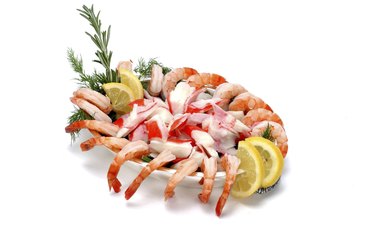
Crab is a costly and highly perishable ingredient, and its price and availability can fluctuate wildly as coastal fishing seasons open and close. Many manufacturers offer a more pragmatic alternative in the form of imitation crab meat, usually sold in conveniently meal-sized vacuum packaging. It's fully cooked during the manufacturing process and often is eaten cold, but you can use it as a crab substitute in certain cooked dishes.
What It Is
Video of the Day
Imitation crab meat typically is referred to by the Japanese word "surimi," because it was first brought to market by Japanese companies. Most surimi sold in the United States is made with Alaskan pollock, a sustainable and well-managed fish. The meat is de-boned, cooked and bound together with ingredients such as the enzyme transglutaminase -- sometimes colloquially called "meat glue" -- or lower-tech egg whites. Then it's flavored and colored to resemble chunk or flaked crab meat, or longer pieces that simulate shelled snow crab or king crab leg segments. Good-quality surimi is a fine product in its own right, although it doesn't quite match the flavor and texture of good crab. Lower-quality surimi can be soft or rubbery, indicating too little or too much binder.
Video of the Day
On Its Own
If you're going to serve the imitation snow crab legs on their own, they need the gentlest form of reheating you can muster. Some packages are designed to be dropped in simmering water, heating the "legs" gently without affecting their flavor. If yours aren't in that style of packaging, you can steam them for two to three minutes in a regular or Chinese-style steamer until just hot. You can use your microwave at half power, warming the surimi for three to five minutes as needed. Frequently rotate and turn the pieces to ensure even warming. If you're serving the surimi this way, without the concealment other ingredients provide, be sure to buy the best variety you can find.
Soups, Casseroles and Pasta Dishes
Imitation snow crab legs, either whole or cut into segments, make a flavorful addition to many seafood-themed dishes. They should be added near the end of cooking so they'll have time to heat up without overcooking and becoming chewy. Add diced legs to your favorite chowder or fish stew for color and flavor. Stir them into your favorite creamy pasta sauce, or warm them first and toss them with the hot sauce and pasta before serving. Chunks of imitation snow crab leg make a fine garnish for risotto or paella. You can even use them in creamy casseroles as long as the other ingredients are precooked and don't require long baking times.
Crab Cakes
Imitation snow crab legs can be used to make a variation of crab cakes. Use your favorite crab-cake recipe, substituting coarsely chopped sections of the imitation snow crab legs for the lump crab meat you'd ordinarily use. Omit any salt the recipe calls for because surimi already is well seasoned. Form the crab mixture into small or medium patties and bread them on both sides, then fry them over moderate heat until they're golden brown.